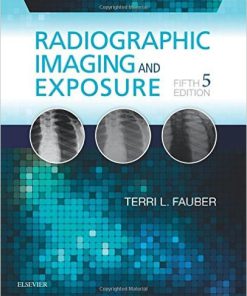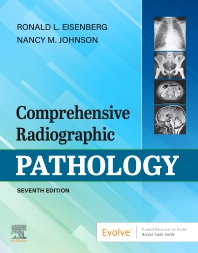Test Bank For Comprehensive Radiographic Pathology 5th Edition by Eisenberg Test bank
$55.00 Original price was: $55.00.$29.99Current price is: $29.99.
Test Bank For Comprehensive Radiographic Pathology 5th Edition by Eisenberg Test bank
Instant download Test Bank For Comprehensive Radiographic Pathology 5th Edition by Eisenberg Test bank pdf docx epub after payment.

Chapter 6: Urinary System
Test Bank
MULTIPLE CHOICE
1. What is the functional unit of the kidney?a. Lobuleb. Nephronc. Glomerulusd. Ureterocele
ANS: BThe functional unit of the kidney is the nephron.
REF: p. 217
2. In an average person, the nephrons filter about _____ L of water out of glomerular blood each 2b. 10c. 80d. 190
ANS: DThe nephrons filter about 190 L of water out of the glomerular blood each day. Only about 1 to 2 L of water is excreted in urine, so about 99% of the filtered water is reabsorbed into the tubular blood.
REF: p. 217
3. Where does the formation of urine begin?a. Nephronsb. Bowman’s capsulec. Glomerulusd. Distal convoluted tubule
ANS: CThe formation begins in the glomerulus, which is a tuft of capillaries surrounded by the Bowman’s capsule. Nephrons are the basic, functional unit of the kidneys. The distal convoluted tubule is where the electrolyte and acid-base balance of the blood occurs.
REF: p. 217
4. Which of the following stimulates the rate of red blood cell production?a. Erythropoietinb. Angiotensinc. Renind. Aldosterone
ANS: AErythropoietin is produced by the kidneys and stimulates red blood cell production. Angiotensin secretion is controlled by renin and affects blood pressure. Aldosterone is secreted by the adrenals and affects the reabsorption of sodium and chloride during urine formation.
REF: p. 219
5. A miniature replica of a kidney is termed:a. Ectopic kidneyb. Hypoplastic kidneyc. Compensatory hypertrophyd. Supernumerary kidney
ANS: BA hypoplastic kidney is a miniature replica of a kidney with normal function. It must be differentiated from acquired atrophic kidney, which is smaller in size as a result of vascular or inflammatory disease.
REF: p. 220
6. A rare anomaly in which a kidney fails to develop is called:a. Unilateral renal agenesisb. Hypoplastic kidneyc. Compensatory hypertrophyd. Supernumerary kidney
ANS: AUnilateral renal agenesis is a rare anomaly in which one kidney fails to develop and is associated with various other developmental anomalies. Complete renal agenesis is not compatible with life.
REF: p. 220
7. What term is applied to an acquired condition that occurs when one kidney is required to do the job of two?a. Supernumerary kidneyb. Crossed ectopiac. Compensatory hypertrophyd. Hypoplastic kidney
ANS: CCompensatory hypertrophy is an acquired condition that occurs when one kidney is required to do the job of two.
REF: p. 220
8. A rare anomaly in which there is a third, rudimentary kidney is termed:a. An ectopic kidneyb. Compensatory hypertrophyc. Hypoplastic kidneyd. Supernumerary kidney
ANS: DSupernumerary kidney is a rare anomaly in which there is a third, rudimentary kidney. These usually function normally, but acquire secondary infections, which require their eventual removal.
REF: p. 220
9. What is an ectopic kidney?a. A third rudimentary kidneyb. A kidney that is not located in the normal locationc. A kidney that is enlarged because it has to do the job of both kidneysd. The most common type of fusion anomaly
ANS: BAn ectopic kidney is a kidney that is not located in the normal location. It may be found in the pelvis or the thorax.
REF: p. 220
10. What is the most common type of fusion anomaly?a. Horseshoe kidneyb. Crossed ectopiac. Doughnut kidneyd. Unilateral renal agenesis
ANS: AHorseshoe kidney is the most common type of fusion anomaly in which the kidneys are joined at their lower poles.
REF: p. 221
11. When the kidneys are fused at their lower poles, they are termed a(an):a. Doughnut kidneyb. Lump kidneyc. Horseshoe kidneyd. Ectopic kidney
ANS: CHorseshoe kidney is the term applied to the most common fusion anomaly, in which the kidneys are fused at their lower poles.
REF: p. 221
12. Refer to the image below. What developmental anomaly is demonstrated? a. Crossed ectopiab. Horseshoe kidneyc. Unilateral renal agenesisd. Supernumerary kidney
ANS: BThe arrows point to the outline of the fused, horseshoe kidneys.
REF: p. 222
13. Cystic dilatation of the distal ureter near its insertion into the urinary bladder is called a:a. Ureteroceleb. Pyelonephritisc. Ureteral aneurysmd. Renal cyst
ANS: AA ureterocele is a cystic dilatation of the distal ureter near its insertion into the urinary bladder. Most occur in children with ureteral duplication.
REF: p. 223
14. What is a ureterocele?a. A nonsuppurative inflammatory process involving the tufts of the capillaries within the Bowman’s capsuleb. A smaller than normal amount of urinec. A fusion anomaly in which the ureter is directly connected to the kidneyd. A cystic dilatation of the distal ureter near its insertion into the urinary bladder
ANS: DA ureterocele is a cystic dilatation of the distal ureter near its insertion into the urinary bladder. Most occur in children with ureteral duplication.
REF: p. 223
15. Which condition is most commonly found in children with ureteral duplication?a. Renal cystb. Ureterocelec. Papillary necrosisd. Staghorn calculus
ANS: BA ureterocele is a cystic dilatation of the distal ureter near its insertion into the urinary bladder. Most occur in children with ureteral duplication.
REF: p. 223
16. A nonsuppurative inflammatory process involving the tufts of the capillaries within the Bowman’s capsule is called:a. Ureteroceleb. Pyelonephritisc. Glomerulonephritisd. Papillary necrosis
ANS: CGlomerulonephritis is a nonsuppurative inflammatory process involving the glomerulus, which is the tufts of the capillaries within the Bowman’s capsule.
REF: p. 223
17. A smaller than normal amount of urine is termed:a. Polyuriab. Oliguriac. Hematuriad. Dysuria
ANS: BOliguria is a smaller than normal amount of urine, which is symptomatic of some urinary abnormalities.
REF: p. 225
18. What is oliguria?a. A smaller than normal amount of urineb. A larger than normal amount of urinec. The presence of protein molecules in the urined. The presence of fat molecules in the urine
ANS: AOliguria is a smaller than normal amount of urine and is symptomatic of certain urinary conditions.
REF: p. 225
19. A suppurative inflammatory process of the kidney and renal pelvis is termed:a. Glomerulonephritisb. Papillary necrosisc. Cystitisd. Pyelonephritis
ANS: DPyelonephritis is a suppurative inflammatory process of the kidney and renal pelvis.
REF: p. 225
20. Which type of severe infection occurs almost exclusively in diabetic patients and causes acute necrosis of the entire kidney?a. Cystitisb. Papillary necrosisc. Glomerulonephritisd. Emphysematous pyelonephritis
ANS: DEmphysematous pyelonephritis is a severe form of acute parenchymal and perirenal infection that occurs almost exclusively in patients with diabetes.
REF: p. 227
21. What is the most common hospital-acquired infection?a. Cystitisb. Pyelonephritisc. Vasculitisd. Tuberculosis
ANS: AThe most common hospital-acquired infection is cystitis, an infection of the urinary bladder.
REF: p. 228
22. Which imaging modality is the safest and most accurate in detecting renal calculi?a. Ultrasoundb. Excretory urographyc. Noncontrast helical CTd. MRI
ANS: CNoncontrast helical CT is the safest, easiest, and most accurate modality for the diagnosis of kidney stones. Excretory urography can detect stones, but it is not as accurate as helical CT.
REF: p. 230
23. What term is applied to a renal calculus that completely fills the renal pelvis?a. Pelvolithiasisb. Staghorn calculusc. Pelvocalcinosisd. Nephrocalcinosis
ANS: BA staghorn calculus is the term given to a stone that completely fills the renal pelvis.
REF: p. 232
24. What is nephrocalcinosis?a. A condition of calcium deposits within the renal parenchymab. A renal calculus that fills the entire renal pelvisc. Excretion of calcium ions in the urined. A severe infection of the renal parenchyma
ANS: ANephrocalcinosis is a condition of calcium deposits within the renal parenchyma. The pattern can vary from small, punctate densities to extensive, dense calcifications in the kidneys.
REF: p. 232
25. Calcium deposits within the renal parenchyma are termed:a. Staghorn calculusb. Nephrolithiasisc. Nephrocalcinosisd. Glomerulonephritis
ANS: CNephrocalcinosis is the condition of calcium deposits within the renal parenchyma. Nephrolithiasis is the medical term for kidney stones, and a staghorn calculus is a type of kidney stone that fills the renal pelvis and calyces. Glomerulonephritis is an infection.
REF: p. 232
26. What is the cause of hydronephrosis?a. Chronic glomerulonephritisb. Blockage above the level of the bladderc. Staghorn calculusd. Aldosterone deficiency
ANS: BBlockage of urine passage into the urinary bladder causes the ureter and renal collecting system to dilate. Dilatation of the pelvis and calyces is called hydronephrosis.
REF: p. 234
27. Blockage above the level of the bladder causes dilatation of the renal pelvicalyceal system, which is called:a. Glomerulonephritisb. Cystitisc. Hypernephromad. Hydronephrosis
ANS: DBlockage of urine passage into the urinary bladder causes the ureter and renal collecting system to dilate. Dilatation of the pelvis and calyces is called hydronephrosis.
REF: p. 234
28. Stone formation in the bladder occurs primarily in _____ with obstruction or infection of the lower urinary Childrenb. Young adultsc. Elderly malesd. Diabetic persons
ANS: CStone formation in the bladder occurs primarily in elderly males with obstruction or infection of the lower urinary tract.
REF: p. 232
29. What is the most common unifocal mass of the kidney?a. Staghorn calculusb. Hypernephromac. Nephrocalcinosisd. Renal cyst
ANS: DSimple renal cysts are the most common unifocal masses of the kidney. They are fluid-filled sacs that vary in size.
REF: p. 236
30. The most common renal neoplasm is a:a. Hypernephromab. Nephroblastomac. Pyelocarcinomad. Renal cell sarcoma
ANS: AThe most common renal neoplasm is a hypernephroma, also called renal cell carcinoma. A nephroblastoma is the most common abdominal neoplasm in infants and children.
REF: p. 239
31. Which of these is a common symptom of a renal neoplasm?a. Hydronephrosisb. Painless hematuriac. Proteinuriad. Renal neoplasms are asymptomatic.
ANS: BThe most common symptom of renal neoplasm in persons over age 40 is painless hematuria.
REF: p. 239
32. What is the most common abdominal neoplasm of infancy and childhood?a. Hypernephromab. Wilms’ tumorc. Polycystic kidneysd. Renal cell carcinoma
ANS: BA Wilms’ tumor or nephroblastoma is the most common abdominal neoplasm in infancy and childhood.
REF: p. 242
33. What condition most commonly occurs in children who are severely dehydrated?a. Nephrolithiasisb. Glomerulonephritisc. Pyelonephritisd. Renal vein thrombosis
ANS: DRenal vein thrombosis occurs most frequently in children who are severely dehydrated.
REF: p. 244
34. What is the imaging modality of choice to diagnose renal vein thrombosis?a. CTb. MRIc. USd. Excretory urography
ANS: CUltrasound (US) is the imaging modality of choice for imaging of renal vein thrombosis and can show the clot with Doppler.
REF: p. 245
35. Which of the following are causes of enlarged kidneys?(1) Polycystic renal disease(2) Renal vein thrombosis(3) Nephrosclerosisa. 1 and 2 onlyb. 1 and 3 onlyc. 2 and 3 onlyd. 1, 2, and 3
ANS: AEnlarged kidneys are indicative of polycystic renal disease, renal vein thrombosis, obstruction, and infiltrative processes, such as myeloma and lymphoma.
REF: p. 237 | p. 245
36. Which of the following are causes of small kidneys with smooth contours?(1) Renal vein thrombosis(2) Nephrosclerosis(3) Chronic glomerulonephritisa. 1 and 2 onlyb. 1 and 3 onlyc. 2 and 3 onlyd. 1, 2, and 3
ANS: CSmall kidneys with smooth contours are indicative of chronic glomerulonephritis and nephrosclerosis. Renal vein thrombosis causes enlarged kidneys.
REF: p. 247
37. The medical term that means to void or empty the bladder of urine is:a. incontenienceb. continatec. micturated. uremia
ANS: CMicturate is the medical term for voiding or emptying the bladder of urine.
REF: p. 217
38. What term is used to describe abnormally positioned kidneys?a. Kidney agenesisb. Ectopic kidneyc. Kidney aplasiad. Hypertrophic kidney
ANS: BEctopic kidney describes a kidney that is abnormally placed.
REF: p. 217
39. Refer to the image. Note the arrows. What condition is indicated by the arrows in this image of an intravenous urogram? a. Ureteroceleb. Kidney agenesisc. Ectopic kidneyd. Hypertrophic kidney
ANS: CA kidney that is misplaced from its normal position is termed an ectopic kidney. In this image, the kidney is located in the pelvis and may be more accurately described as a pelvic kidney.
REF: p. 220
40. Which urinary disease occurs almost exclusively in males and is defined as a thin transverse membrane that causes bladder outlet obstruction and may lead to severe hydronephrosis, hydroureter, and renal damage?a. Ureteroceleb. Posterior urethral valvesc. Benign prostatic hyperplasiad. Polycystic kidney disease
ANS: BPosterior urethral valves are thin transverse membranes, found almost exclusively in males, which cause bladder outlet obstruction and may lead to severe hydronephrosis, hydroureter, and renal damage.
REF: p. 221
TRUE/FALSE
1. The functional unit of the kidney is the Trueb. False
ANS: TThe nephron is the functional unit of the kidney.
REF: p. 220
2. Urine formation begins in the Trueb. False
ANS: TUrine formation begins in the glomerulus of the kidney.
REF: p. 223
3. A hypoplastic kidney is a small, third kidney and a rare developmental Trueb. False
ANS: FSupernumerary kidney is the term applied to a small, third kidney.
REF: pp. 228-229
4. Horseshoe kidney is the most common fusion anomaly of the urinary Trueb. False
ANS: THorseshoe kidney is fusion of the kidneys at the lower poles and is the most common fusion anomaly of the urinary system.
REF: p. 223
5. Ectopic kidney describes when a kidney fails to Trueb. False
ANS: FEctopic kidney describes when a kidney is in an abnormal location.
REF: p. 230
6. Ureteroceles are commonly associated with duplicated Trueb. False
ANS: TUreteroceles are seen almost exclusively in children with duplication anomalies of the ureters.
REF: p. 239
7. Chronic cystitis is evidenced radiographically by a decrease in bladder size and wall Trueb. False
ANS: TRadiographic evidence of chronic cystitis is a decrease in bladder size and irregularity of the bladder wall.
REF: p. 219
8. Glomerulonephritis is the most common nosocomial Trueb. False
ANS: FCystitis is the most common hospital-acquired or nosocomial infection.
REF: p. 220
9. Urinary calculi are asymptomatic while they are in the Trueb. False
ANS: TUrinary calculi are asymptomatic while they are in the kidney. They become painful when they lodge in the ureter.
REF: p. 221
10. Painless hematuria is a common presentation of a Trueb. False
ANS: TA common symptom of a hypernephroma is painless hematuria.
REF: p. 223
MATCHING
Match the disease to its Nonsuppurative inflammation of the tuft of the capillaries in the Bowman’s capsuleb. Suppurative infection of kidney and renal pelvisc. Inflammation of the urinary bladderd. A destructive condition involving the terminal portion of the renal pyramids
1. Cystitis
2. Glomerulonephritis
3. Pyelonephritis
4. Papillary necrosis
1. ANS: C REF: p. 228 NOT: Rationale: Cystitis is inflammation of the urinary bladder caused by bacteria traveling up the urethra to cause an infection in the bladder. Glomerulonephritis is a bacterial infection of the glomerulus. Pyelonephritis is an infection of the kidneys and renal pelves caused by a pyogenic bacterium. Papillary necrosis is destruction of the papillae of the medulla and the terminal portion of the renal pyramids.
2. ANS: A REF: p. 223 NOT: Rationale: Cystitis is inflammation of the urinary bladder caused by bacteria traveling up the urethra to cause an infection in the bladder. Glomerulonephritis is a bacterial infection of the glomerulus. Pyelonephritis is an infection of the kidneys and renal pelves caused by a pyogenic bacterium. Papillary necrosis is destruction of the papillae of the medulla and the terminal portion of the renal pyramids.
3. ANS: B REF: p. 225 NOT: Rationale: Cystitis is inflammation of the urinary bladder caused by bacteria traveling up the urethra to cause an infection in the bladder. Glomerulonephritis is a bacterial infection of the glomerulus. Pyelonephritis is an infection of the kidneys and renal pelves caused by a pyogenic bacterium. Papillary necrosis is destruction of the papillae of the medulla and the terminal portion of the renal pyramids.
4. ANS: D REF: p. 228 NOT: Rationale: Cystitis is inflammation of the urinary bladder caused by bacteria traveling up the urethra to cause an infection in the bladder. Glomerulonephritis is a bacterial infection of the glomerulus. Pyelonephritis is an infection of the kidneys and renal pelves caused by a pyogenic bacterium. Papillary necrosis is destruction of the papillae of the medulla and the terminal portion of the renal pyramids.
Match the disease to the imaging modality that is most commonly used to diagnose Contrast-enhanced CTb. Ultrasoundc. Noncontrast helical CTd. MRI
5. Glomerulonephritis
6. Pyelonephritis
7. Acute renal failure
8. Kidney stones
5. ANS: B REF: p. 225 NOT: Rationale: Ultrasound is the imaging modality of choice for many urinary diseases because it is not dependent upon renal function and does not further damage renal tissue with the administration of contrast media. Ultrasound is particularly useful in acute and chronic renal failure and glomerulonephritis. Pyelonephritis is demonstrated well by contrast-enhanced CT, which demonstrates cortical changes and abscesses. Kidney stones are best demonstrated by noncontrast helical CT.
6. ANS: A REF: p. 226 NOT: Rationale: Ultrasound is the imaging modality of choice for many urinary diseases because it is not dependent upon renal function and does not further damage renal tissue with the administration of contrast media. Ultrasound is particularly useful in acute and chronic renal failure and glomerulonephritis. Pyelonephritis is demonstrated well by contrast-enhanced CT, which demonstrates cortical changes and abscesses. Kidney stones are best demonstrated by noncontrast helical CT.
7. ANS: B REF: p. 246 NOT: Rationale: Ultrasound is the imaging modality of choice for many urinary diseases because it is not dependent upon renal function and does not further damage renal tissue with the administration of contrast media. Ultrasound is particularly useful in acute and chronic renal failure and glomerulonephritis. Pyelonephritis is demonstrated well by contrast-enhanced CT, which demonstrates cortical changes and abscesses. Kidney stones are best demonstrated by noncontrast helical CT.
8. ANS: C REF: p. 230 NOT: Rationale: Ultrasound is the imaging modality of choice for many urinary diseases because it is not dependent upon renal function and does not further damage renal tissue with the administration of contrast media. Ultrasound is particularly useful in acute and chronic renal failure and glomerulonephritis. Pyelonephritis is demonstrated well by contrast-enhanced CT, which demonstrates cortical changes and abscesses. Kidney stones are best demonstrated by noncontrast helical CT.
You may also like…
Test Bank
Test Bank for Comprehensive Radiographic Pathology, 7th Edition, Ronald Eisenberg Nancy Johnson












